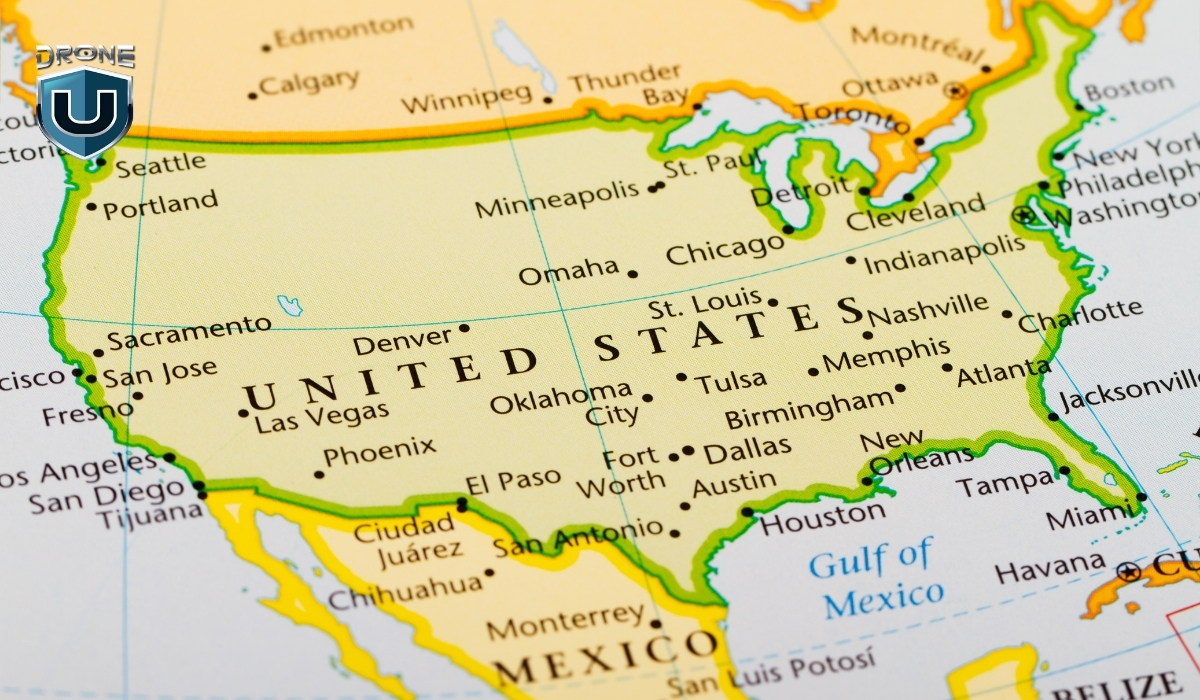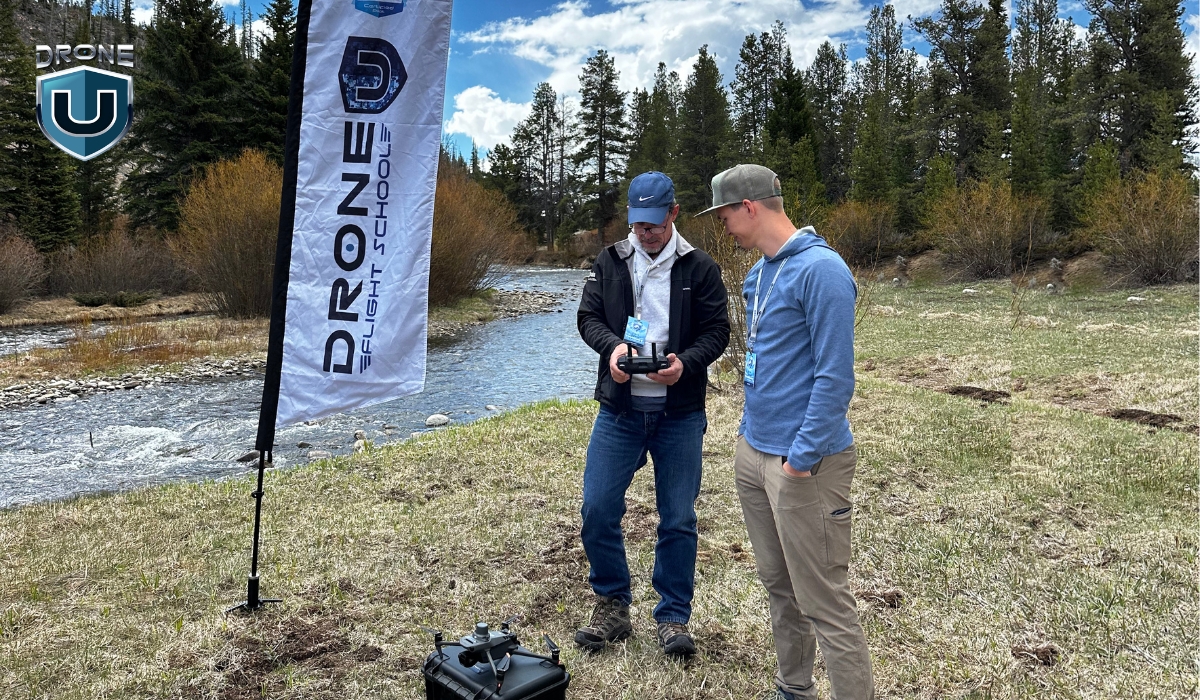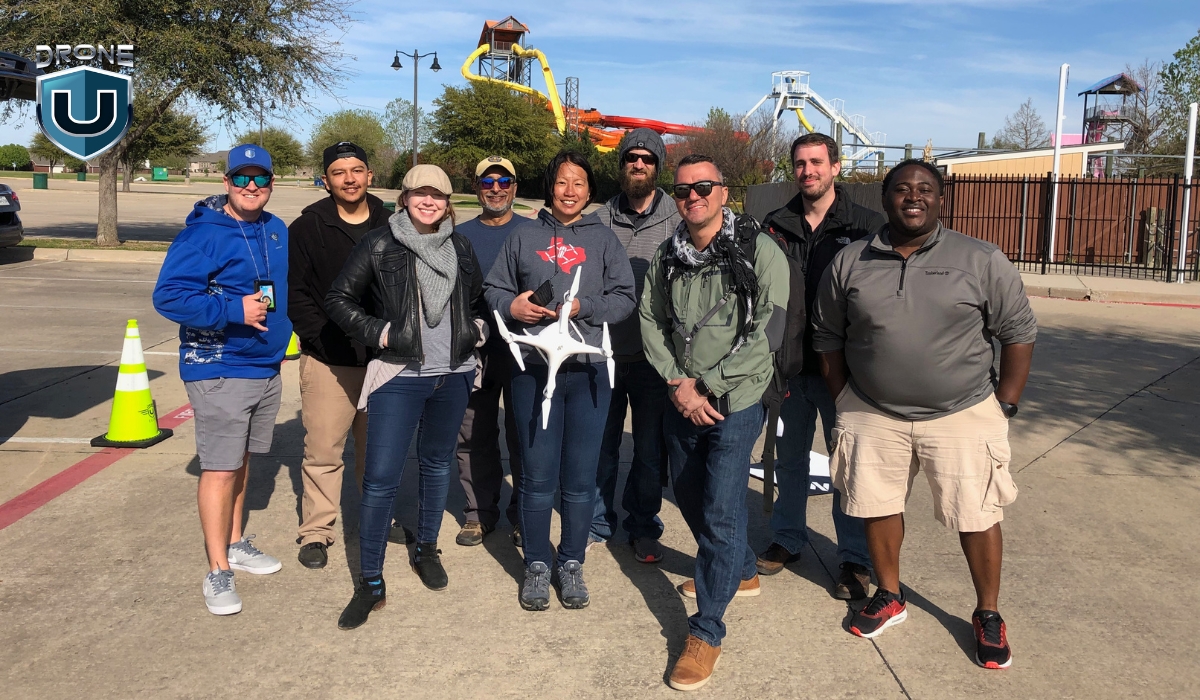![New Drone Laws in the USA [Updated in 2025]](https://www.thedroneu.com/wp-content/uploads/2024/01/New-Drone-Laws-in-the-USA-1024x597.jpg)
The FAA regulates drone usage in the United States through comprehensive guidelines for both recreational and commercial operators. This guide provides up-to-date information on the latest USA drone laws requirements in the U.S.
With the rising adoption of UAVs, the FAA and state authorities have been continuously working towards making drone laws practical while preventing drone misuse and protecting citizens.
We keep a close eye on the updates and keep this information as recent as possible.
Disclaimer: This guide is for informational purposes only. Always check the latest guidelines on the FAA website.
Here is a quick overview of the new drone laws in the USA.
Quick Overview of FAA Drone Laws
- Drones are regulated by the Federal Aviation Administration (FAA).
- All drone pilots must follow FAA safety guidelines.
- Registration is mandatory for drones over 0.55 lbs (250g).
- You must operate within the visual line of sight (VLOS).
- Remote ID is now mandatory for most drone flights.
- Different rules apply for recreational, commercial, and foreign pilots.
- Never fly your drone under the influence of drugs or alcohol.
- Do not fly over people, moving vehicles, or large crowds.
FAA New Rules and Drone Laws in the USA

It is legal to fly drones in the United States as long as you follow the rules set by the Federal Aviation Administration (FAA).
The Federal Aviation Administration (FAA) manages most of the airspace in the United States. It has laid out clear regulations that every drone pilot must understand and follow.
To make things easier for you, I’ve divided the information into four key sections. Feel free to jump straight to the one that applies to you:
- General Drone Rules – Basic regulations every pilot must follow
- Rules for Recreational Pilots – For hobbyists or those flying just for fun
- Rules for Commercial Pilots – For professionals looking to earn money with drones
- Rules for Foreign Pilots – For non-U.S. citizens who want to fly drones in the U.S.
Let’s start with the general rules.
1. General Drone Flying Laws & Federal Regulations

These are some of the most common rules when flying drones in the U.S., but there may be additional regulations in certain states.
No matter your purpose, all drone pilots must adhere to these fundamental regulations:
1. You must fly your drone at or below 400 feet.
2. All eligible drones (over 250 g to 25 kg) must be registered with the FAA
3. Your drone must be marked with your FAA registration number.
4. Use B4UFLY Mobile App – the safety app from the FAA, which uses your GPS location to provide real-time information about airspace restrictions and other flying requirements.
5. Be aware of and avoid no-fly zones, especially around airports and other restricted areas.
6. You must fly within the visual line of sight so that you or the observer can see the drone at all times.
7. You must understand and comply with airspace restrictions, especially around airports.
8. You must comply with Remote ID requirements unless flying in a FRIA (FAA-Recognized Identification Area).
9. Always give way to and do not interfere with other aircraft.
10. Use the Low Altitude Authorization and Notification Capability (LAANC) system for controlled airspace authorization.
Note: Anyone flying a drone in the U.S. National Airspace System (NAS) is responsible for flying within the FAA guidelines and regulations.
2. Drone Regulations for Recreational Pilots

If you’re flying drones as a recreational pilot or for fun, you must:
1. Pass the TRUST exam (The Recreational UAS Safety Test).
2. Carry proof of TRUST completion while flying your drone.
3. Follow the safety guidelines of an FAA-recognized CBO (Community Based Organization).
3. Fly your drone at or below 400 feet in Class G (uncontrolled) airspace.
4. Obtain proper authorization through LAANC or DroneZone before flying in controlled airspace (Class B, Class C, Class D, and Class E airspace).
5. Keep a current FAA registration, mark your drones on the outside with the registration number, and carry proof of registration during all flights.
6. Avoid operating your drone in a way that risks the safety of the national airspace.
If you’re not sure which category you fall into, fly under Part 107 (commercial rules).
There are some exceptions for Limited Recreational UAV Operations. You can read Advisory Circular 91-57C for more information.
3. Drone Regulations For Commercial Drone Pilots

If you want to fly your drone for work, such as mapping, filming, or public safety, it is considered a commercial activity. In that case, you must follow the following drone laws:
1. To fly drones commercially, you must obtain a Remote Pilot Certificate – Part 107 license from the FAA.
2. You must pass the initial aeronautical knowledge exam: “Unmanned Aircraft General – Small (UAG)”.
3. You must be at least 16 years old.
4. You must be able to understand, read, write, and speak English.
5. You must be mentally and physically able to operate a UAV safely.
6. Before signing up for the knowledge test, create an IACRA (Integrated Airman Certification and Rating Application) profile and obtain an FAA Tracking Number (FTN).
7. You can fly drones at night, over people, and moving vehicles without a waiver under Part 107 as long as the rules are followed. However, you still need airspace authorization for night operations in controlled airspace under 400 feet.
To learn more about how to get a Remote Pilot Certificate, you can check out our guide.
4. FAA Drone Laws for Foreigners Visiting the USA

Foreign visitors planning to fly drones in the United States must follow the applicable drone laws:
| For Recreational Use | For Commercial Use |
| Follow all rules for Recreational Flyers (TRUST exam) | Comply with all applicable rules and requirements for Commercial Flyers (Part 107 exam) |
| Register through the FAA’s DroneZone portal | Obtain a foreign aircraft permit issued by the Department of Transportation before any U.S. commercial operations |
| Complete the process under “The Exception for Recreational Flyers” | Follow the permit application process under Part 375 |
Note: For foreign operators, the FAA considers the issued certificate as recognition of ownership rather than a U.S. aircraft registration certificate.
Tip: Consider travel insurance that includes liability for drone flights.
Next, let’s discuss an important rule announced by the FAA.
FAA New Remote ID Drone Rules [2025 Update]
Since September 16, 2023, most drone pilots must comply with Remote ID regulations:
| Remote ID functions as a “digital license plate” for drones, broadcasting identification and location information during flight. |
For more information, check out our article on Remote ID.
As of 2025, all drones that require registration must broadcast a Remote ID signal.
You can comply in three ways:
1. Standard Remote ID Drone (Drones with built-in Remote ID capability).
2. Remote ID Broadcast Module (Add-on to drones).
3. FAA-Recognized Identification Area (FRIA) for non-RID drones only.
We’ve covered the key drone laws and regulations so far, but you might still have questions about registering your drone. Let’s explore that in the next section.
How to Register My Drone With the FAA
| To determine what type of drone pilot you are, use the FAA’s User Identification Tool or visit the Getting Started page for more information. |
If your drone weighs more than 250 grams, you are required to register it with the FAA. However, if it is under 250 grams and you’re flying solely for recreational purposes, registration is not required.
Where to Register a Drone
- Register a drone by mail
- Register a drone online at FAADroneZone (drone must be less than 55 pounds)
You need to provide basic information when registering your drone, such as:
- Make and model of your drone
- Email address
- Physical address and mailing address (if both are different)
- Phone number
- Payment method (Credit or debit card)
- Specific Remote ID serial number provided by the manufacturer (if applicable)
FAA Drone Registration Requirements
- You need to be at least 13 years old. If you’re under 13 years of age, someone older must register the drone for you.
- A U.S. citizen or legal permanent resident of the United States.
Drone Registration Fees and Validity
- Cost: $5 per drone registration
- Validity: Registration is valid for three years
Note: Once you have registered your drone, you can’t transfer between types (part 107 or the Exception for Recreational Flyers).
Frequently Asked Questions
1. Are drones allowed in the USA?
Drones are permitted in the United States of America for both recreational and commercial purposes, subject to FAA and local regulations. The Federal Aviation Administration (FAA) approves commercial drone flights under Part 107 and flying recreational drones under the FAA TRUST test.
2. Can tourists bring drones to the USA?
Yes, but they must register and follow FAA rules just like residents.
3. Do I need a license to fly a drone recreationally?
No, but you must pass the TRUST test and carry proof of completion.
4. Can I fly a drone in a national park?
No. Drone use is banned in all U.S. National Parks (state laws vary) unless you have a special permit.
5. Can you fly a drone at night?
Yes, you can fly drones at night under Part 107. However, airspace authorizations are required for night operations in controlled airspace under 400 feet. For more information, visit the Part 107 Waiver page.
6. Can I fly in a NOAA-protected area?
Watch this video to get the answer:








Add Your Comment